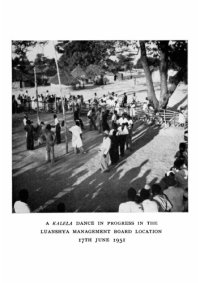
Ebook: The Kalela Dance: Aspects of Social Relationships among Urban Africans in Northern Rhodesia
Author: J. Clyde Mitchell
- Tags: Africa, Zambia, Northern Rhodesia, social anthropology, urbanization, interethnic relationships, interethnic relations, urban studies African studies, anthropology, ethnology
- Series: The Rhodes-Livingstone Institute Papers 27
- Year: 1956
- Publisher: The Rhodes-Livingstone Institute
- City: Lusaka; Manchester; New York
- Edition: 1959 Reprint
- Language: English
- pdf
"An analysis of certain aspects of the system of social relationships among Africans in the towns of Northern Rhodesia. Urban studies have been part of the tradition of the Rhodes-Livingstone Institute from the days of its inception. Kalela is the name of a popular 'tribal' dance on the Copperbelt of Northern Rhodesia. Certain puzzling features attracted my attention to it when I was engaged in field work and I have used it as a vehicle for general enquiry into tribalism and some other features of social relationships among Africans in the towns of Northern Rhodesia. I start with a description of the kalela dance and then relate the dominant features of the dance to the system of relationships among Africans on the Copperbelt. In order to do this I must take into account, to some extent, the general system of Black-White relationships in Northern Rhodesia. By working outwards from a specific social situation on the Copperbelt the whole social fabric of the Territory is therefore taken in. It is only when this process has been followed to a conclusion that we can
return to the dance and fully appreciate its significance."
The Copperbelt, as a conurbation of an immigration area of over 90 language groups, who mainly worked in copper mining and smelting, had originally brought together hostile tribal groups and also fueled new inter-ethnic tensions. The Kalela Dance, at its core a round dance of men with a few fixed costumed figures (for example "the Doctor") with conventional rhythms and musical instruments, consisted for the pleasure of the spectators of long, well-known, but mostly up-to-date poetry of mocking verses of individual groups about each other. Like other joking relationships, it had a double function in the sense of Max Gluckman's Custom and Conflict in Africa: it expressed social conflicts in a pronounced way, but defused their execution in everyday life.
return to the dance and fully appreciate its significance."
The Copperbelt, as a conurbation of an immigration area of over 90 language groups, who mainly worked in copper mining and smelting, had originally brought together hostile tribal groups and also fueled new inter-ethnic tensions. The Kalela Dance, at its core a round dance of men with a few fixed costumed figures (for example "the Doctor") with conventional rhythms and musical instruments, consisted for the pleasure of the spectators of long, well-known, but mostly up-to-date poetry of mocking verses of individual groups about each other. Like other joking relationships, it had a double function in the sense of Max Gluckman's Custom and Conflict in Africa: it expressed social conflicts in a pronounced way, but defused their execution in everyday life.
Download the book The Kalela Dance: Aspects of Social Relationships among Urban Africans in Northern Rhodesia for free or read online
Continue reading on any device:

Last viewed books
Related books
{related-news}
Comments (0)